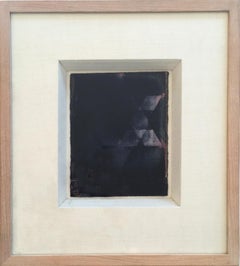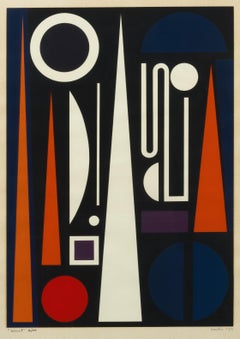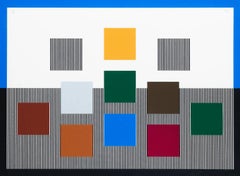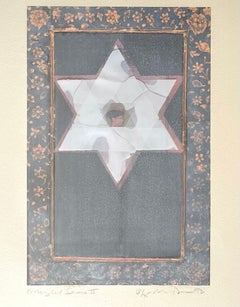Michael David (b. 1954)
Hand signed, Prestige Art blind stamp; edition of 45; 1993
Color Etching on Arches Buff
"The Mugual Series"
Printed by the artist with master printers Sylvia Roth and Mary Seibert at Hudson River Editions and published by Prestige Art Ltd., Mamaroneck, New York.
22 X 18 framed
Michael David Singer; born 1954, is an American painter. Born in Reno, Nevada, David's family relocated to Brooklyn, New York, where he was raised. He attended SUNY Fredonia for one year and in 1976 received a B.F.A. from Parson's School of Design. Michael David is classified as an abstract painter, best known for his use of the encaustic technique, which incorporates pigment with heated beeswax. He is also known for his works in mixed-media figure painting, photography and environmental sculpture. His work is included in the permanent public collections of the Metropolitan Museum of Art, the Guggenheim Museum, the Jewish Museum in New York, the Museum of Contemporary Art in Los Angeles, and the Los Angeles County Museum of Art, among others.
In 1976 David, erotic photographer Roy Stuart and Fredonia friend Richie Stotts formed a band called The Numbers, with David on bass. The group was a fixture in New York's early punk rock music scene, playing in clubs alongside punk pioneers Television, Blondie and the Ramones. David also played bass with punk innovators Jerry Nolan of The New York Dolls, Cheetah Chrome of The Dead Boys, Marky Ramone, Peter Gordon, David Van Tieghem and the free-improvisation noise music group Borbetomagus.
In 1977, The Numbers were approached by impresario Rod Swenson, who was seeking musicians to form a backing band for singer Wendy O. Williams, whose radical persona he sought to exploit as punk music and performance art. The Numbers became The Plasmatics but the attention David began to gain as an important voice in the art world caused him to leave the band to pursue his burgeoning painting career.
David's first one-man show was in 1981 at the historic Sidney Janis Gallery. That year he was awarded a Guggenheim Fellowship, at the time the youngest artist ever to do so, and in 1982 was awarded an American Academy of Arts and Letters prize. He went on to exhibit at galleries worldwide and was represented by Knoedler & Co. for the next 25 years.
David is best known for using the encaustic technique of painting, which uses pigment combined with heated beeswax. David built his early career on abstraction and religious iconography, which formed the bulk of his output until 1999. Since then he has also experimented with representational painting and traditional photography.
In 2000, he developed the "Chortens" and "Populations" series, about which prominent art historian and critic Donald Kuspit writes: "They are enigmatic works, all the more so because of the way their innumerable details form singularly monumental, intimidating wholes. Dense yet delicate, awesome yet intimate, they convey the fragility as well as grandeur of sheer being. Layer upon layer of paint piles up like layer upon layer of coral, but the textural result is more epic, not to say startling, than any coral island, and virtually any other existing abstract expressionist painting (upon which they are stylistically founded)."
In 2001, David developed bi-lateral neuropathy due to being poisoned by gases released by overheated beeswax used in the encaustic process. The disease left him with partial paralysis of his legs, slowing the production of his painting for a number of years. That year, David began painting one of his best-known series, the "fallen Toreadors", inspired by 19th century French Realist painter Édouard Manet's "The Dead Toreador" of 1864.
In 1993, David experimented at the "20x24" Polaroid studio in Manhattan, which resulted in a series of portraits of playwright Edward Albee and of friend Jackie Gross, which would become the ongoing "Jackie" series of mixed-media works. When neuropathy rendered him unable to paint during 2003, he returned to the 20x24 camera and shot large-format Polaroids inspired by Caravaggio; nude men and women dressed as Toreadors, and religious imagery.
In 2002, David began to develop The Greenhouse Project, an evolving "architectural construct" based on historical American Antebellum greenhouses built using the actual glass negatives sold to starving farmers in the post-American Civil War South. David has indicated that each greenhouse will, through the display of photography and use of social networking, create a forum and exhibit for ideas and artifacts related to civil and human rights; the specifications of each greenhouse particular to the community in which each is built.
David's work was reviewed in Artforum and Art in America, and is considered one of the last links to the New York School of painting. David may be the most innovative master of immediate surface since the abstract expressionists. He has acknowledged his debt to Abstract Expressionism, but he has transformed it. Where the abstract expressionist paintings of the forties and fifties seem like modern cave paintings, as their crude, unfocused, often meandering, turbulent painterliness suggests, and as such to reinstate prehistory, David seems to turn the cave into a temple, as his more considered, concentrated, indeed, dense, contemplative painterliness indicates, so that his paintings have the aura of post history.
SELECT GROUP EXHIBITIONS
2010-2011 “Post Mammalian Tension, Michael David & Scott Browning”, Bill Lowe Gallery, Atlanta, GA
2006 “Unspoken Connections,” The Lowe Gallery, Santa Monica, CA
2004 The Lowe Gallery, Atlanta, GA
1999 “Waxing Poetic: Encaustic Art in America,” Montclair Art Museum, Montclair, NJ
“Forty Years of American Drawings,” Raab Galerie, Berlin, Germany
1997 “Michael David and James Hyde,” Margulies Taplin Gallery, Coral Gables, FL
1996 “Different Sides: Drawings/Photographs/Prints/Paintings/Sculpture,” Knoedler and Company, New York, NY
1994 “Michael David: Paintings / Nicholas Pearson: Sculpture,” Margulies Taplin Gallery, Boca Raton, FL
1991 “Working with Wax: Ten Contemporary Artists,” Tibor de Nagy Gallery, New York, NY
1989 “Projects and Portfolios: the 25th Print National,” The Brooklyn Museum, Brooklyn, NY
“Important Works on Paper,” Meredith Long and Company, Houston, TX
“New Editions,” Pace Prints, New York, NY
1988 “Golem! Danger, Deliverance, and Art,” The Jewish Museum, New York, NY
1987 “Monotypes,” Pace Editions, New York, NY
“Working in Brooklyn / Painting,” The Brooklyn Museum, Brooklyn, NY
“Art Against AIDS,” benefit exhibition Knoedler and Company, New York, NY
“Jewish Themes: Contemporary American Artists,” Spertus, Chicago, IL
1986 “First Impressions: Recent Monotypes by 15 Artists,” Allan Frumkin Gallery, (Charles Arnoldi, Pat Steir etc)
“Saints and Sinners: Contemporary Responses to Religion,” De Cordova Museum, Lincoln, MA
“Jewish Themes: Contemporary American Artists,” The Jewish Museum, New York, NY
“Public and Private American Prints Today,” Brooklyn Museum, Brooklyn, NY
1985 “A Decade of Visual Arts at Princeton: 1975-1985,” The Art Museum, Princeton University, Princeton, NJ
1984 “Cunningham Dance Benefit,” Leo Castelli Gallery, New York, NY (Robert Rauschenberg, Arman etc)
Twelve Abstract Painters, Siegel Contemporary (Elizabeth Murray, Melissa Meyer, Leon Polk Smith etc.)
“Small Paintings,” Jeffrey Hoffeld Gallery, New York, NY
1982 “Elaine de Kooning’s Inadvertent Collection,” Elaine Benson Gallery, Bridgehampton, NY
1981 “New Visions,” The Aldrich Museum of Contemporary Art (James Biederman, Louisa Chase,Mel Kendrick etc.)
1980 “Seven Young Americans,” Sidney Janis Gallery, New York, NY (Sean Scully,
Thornton Willis...




